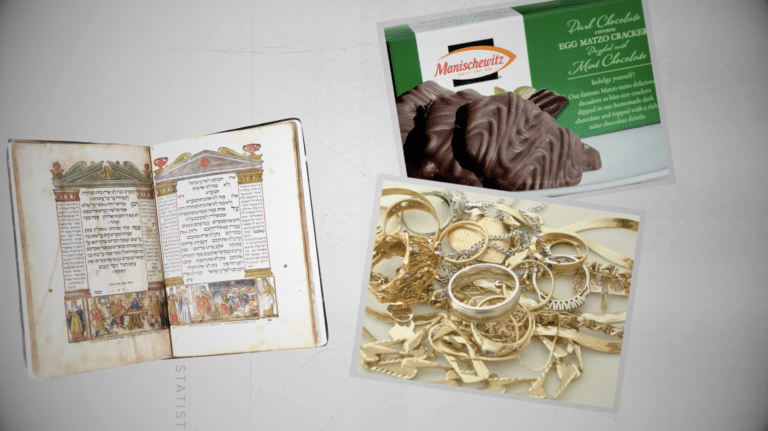
Each Spring, Jews around the world celebrate the holiday of Passover, or Pesach, a commemoration of the Biblical story of the Exodus of the Israelites from Egypt that took place 3,000 years ago.
The centerpiece of the holiday is the seder, a ritual feast on the first night of Passover spent around the table retelling and reflecting on the story of the Israelites’ salvation from slavery in Egypt with prayers, songs, food, and lots of wine. But no two seders are exactly alike. And depending on whose home you’re in, traditions that take place at a seder may look, feel, taste, and sound entirely different.
Here are five unique Passover traditions found in seders around the world.
Yemenite matzah is more like pita
Even the main food item associated with Passover and the seder — matzah — differs among some communities. Matzah is the thin, cracker-like bread Jews eat on Passover. According to the Exodus story, the Hebrew slaves left Egypt in such a hurry that they didn’t even have time to allow their baked bread to rise. So, for symbolic reasons, Jews eat this unleavened bread, aka matzah, during Passover.
Let’s face it, matzah gets a bad rap. Jews give up leavened or fermented grain, or chametz, on Passover, and most people aren’t exactly clamoring for it year-round.
But, some Jewish communities enjoy a very different matzah.
If you go to a seder with a traditional Yemenite-Jewish family, you’ll notice the matzah looks less like a cracker and more like pita bread. This matzah is thicker and softer. AND it’s actually believed to be far more similar to what the Hebrews of the Exodus story likely made.
Prior to the Industrial Revolution, most Jewish communities, even Ashkenazi ones, ate softer matzah. We’re talking as recently as 180 years ago. The hard, square matzah most of us know stays fresh longer and fits nicely in a box, which is one of the main reasons it became the norm, and is mass produced and sold in grocery stores around Passover.
But Yemenite Jews, as well as some other communities, do still enjoy the soft matzah, which only stays good for a day or two.
Persian-Jewish whacking tradition
Something you’ll experience at most seders is a hearty rendition of “Dayenu,” a song whose title translates to “it would have been enough.” The song is a list of miracles God performed in the Exodus story and it’s usually just a fun sing-along. But at a Persian-Jewish seder, it’s… well, a bit of a free-for-all.
Before the singing starts, guests pass around large green onions and… whack each other with the stems.
In case you were wondering… uh, why? Well, the custom is meant to remind us of the slave drivers in Egypt. Some Persian Jews get super into it and really belt each other. So, if you find yourself at a Persian seder, be prepared.
Hungarian Jews get blinged out
While Persian Jews get bruised up on Passover, Hungarian Jews get blinged out.
Jews from Hungary go all out when decorating the seder table. You’ll likely find the table at a traditional Hungarian seder decked out in silver and gold.
According to the story of the Exodus, God bestowed ten plagues on the Egyptians to ultimately force Pharoah to free the Israelite slaves. Some rabbinic interpretations of the Biblical story claim that amid the devastation, the Egyptians even gave their precious metals away to entice the Israelites to speed up their departure from the land.
So, Hungarian Jews lay out all their finest jewelry to serve as a symbolic reminder of this part of the Passover story.
How Gibraltar’s Jews do Charoset
Continuing this talk about symbols… every Jewish seder plate features charoset, a sweet mixture that’s usually made with fruits, nuts, wine, and spices. The name charoset derives from the Hebrew word cheres, meaning clay, which is fitting. Each family has its own unique recipe for charoset… you may find figs, apples, dates, or honey. And in Gibraltar each year families look forward to seeing who will bite into a chunk of brick dust.
What’s consistent is the symbol. Charoset is meant to symbolize the mortar Hebrew slaves used to make bricks…and the Jews of Gibraltar take the symbol quite literally.
In Gibraltar, the tiny British territory jutting off the Iberian peninsula with less than a thousand Jews, Passover seders feature charoset with actual brick dust in it. Some households there use the same brick for decades, shaving off faint amounts of dust with a knife every Passover to put in the charoset.
Modernizing/Personalizing your seder
Now, many seder traditions serve to remind Jews of events from the 3,000-year-old Exodus story. But a somewhat recent and emerging trend is incorporating traditions that personalize and modernize seders.
For example, some Jews draw parallels between the Israelites in Egypt and refugee crises in the twenty-first century. Organizations like HIAS, the Hebrew Immigrant Aid Society, distributes guides that help people weave modern refugee references into the seder. The aim is to bring discussions to Passover seders about how to take real world action to help refugees around the world.
A fun twist seen at some seders is using a customized haggadah, the booklet that guides guests through the many traditions of the Passover meal. Besides the straight-laced Maxwell House haggadah, there are now various takes on the traditional haggadah that grace tables during Passover, including graphic novel iterations, Harry Potter-themed haggadahs, baseball haggadahs, and a popular “hipster” haggadah written by novelists Jonathan Safran Foer and Nathan Englander.
Another modern update to the seder is found on the seder plate, the centerpiece on the table. On a traditional seder plate, items are present that symbolize different aspects of the Passover story. For instance, the bitter herbs represent the bitterness of slavery in Egypt. On some seder plates you’ll notice another item: an orange. This has nothing to do with ancient Egypt. In the 1980s, Susannah Heschel, a well-known Jewish feminist scholar and the daughter of the prominent Rabbi Abraham Joshua Heschel, pioneered the idea of placing an orange on the seder plate. She said the orange symbolizes the fruitfulness that all Jews experience when the entire community, particularly women and LGBTQ members, are included in Jewish life.
Chag sameach!
Like most Jewish holidays, Passover takes on the flavor of customs and traditions unique to different parts of the world. From bruises, to bling, to brick eating, there’s plenty to learn from seder traditions throughout the world… maybe even something you can bring to your own seder? We’re not necessarily advocating sprinkling brick dust into your food, but… hey, when in Gibraltar! Chag sameach!
Originally Published Mar 29, 2021 12:01AM EDT
